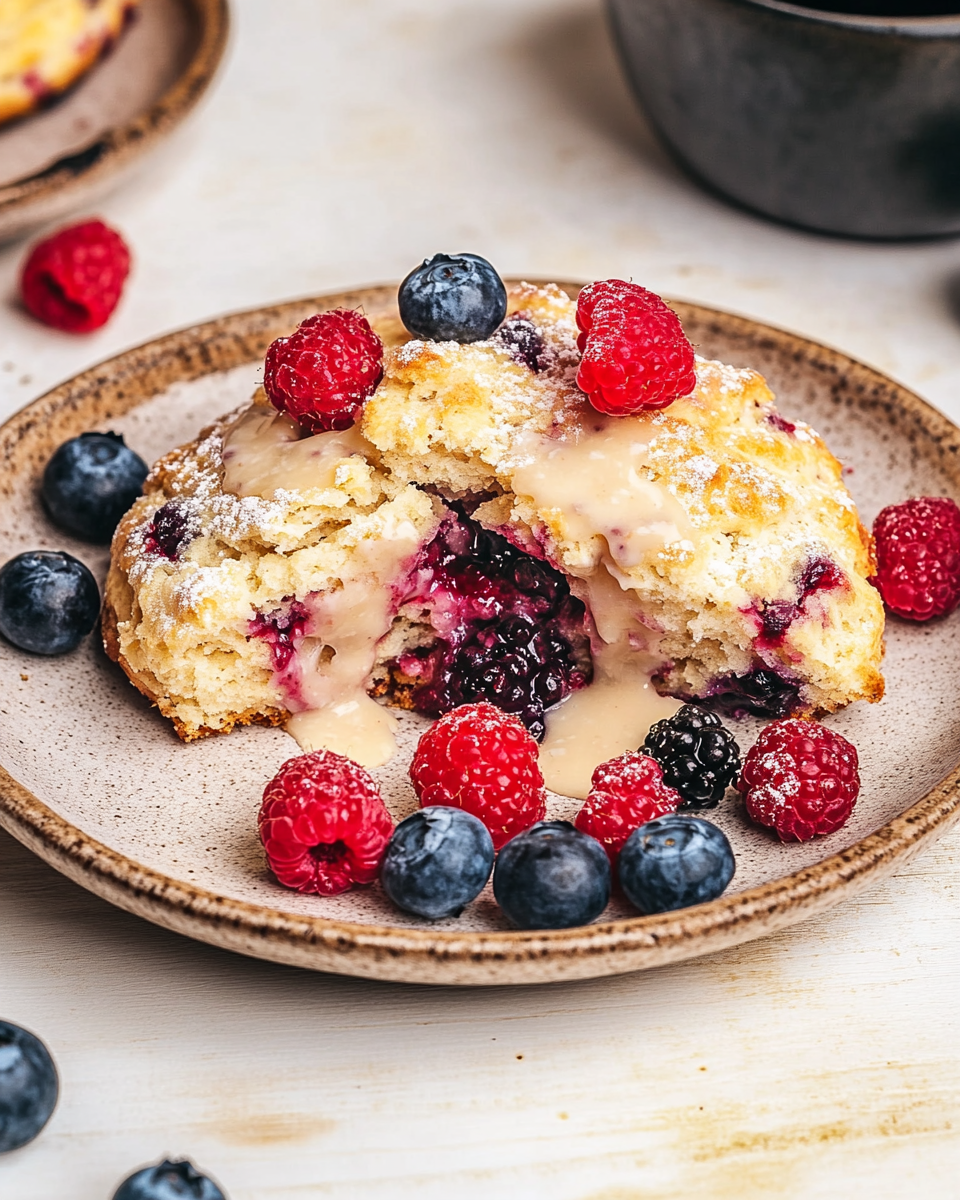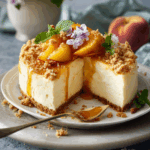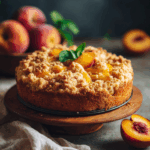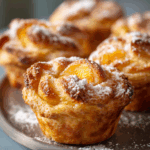These Mixed Berry Garden Scones are tender, buttery, and bursting with juicy berries. Perfect for breakfast, brunch, or a sweet afternoon snack, they’re easy to make and full of flavor. Enjoy them warm with a touch of jam or clotted cream.
FULL RECIPE
Ingredients
- 2 cups all-purpose flour
- 1/4 cup granulated sugar
- 1 tablespoon baking powder
- 1/2 teaspoon salt
- 6 tablespoons cold unsalted butter, cubed
- 3/4 cup heavy cream (plus extra for brushing)
- 1 large egg
- 1 teaspoon vanilla extract
- 1 cup mixed fresh berries (blueberries, raspberries, chopped strawberries)
- Optional: coarse sugar for topping
Directions
- Preheat oven to 400°F (200°C). Line a baking sheet with parchment paper.
- In a large bowl, whisk together flour, sugar, baking powder, and salt.
- Cut in the butter using a pastry cutter or fingers until the mixture resembles coarse crumbs.
- In a small bowl, whisk together the cream, egg, and vanilla. Pour into the dry ingredients and mix just until combined.
- Gently fold in the berries, being careful not to crush them.
- Turn dough onto a floured surface. Pat into a 1-inch thick circle and cut into 8 wedges.
- Transfer scones to the baking sheet. Brush tops with extra cream and sprinkle with coarse sugar if using.
- Bake for 18–22 minutes or until golden brown and cooked through.
- Let cool slightly before serving.
Nutritional Information
- Calories: 280
- Total Fat: 14g
- Saturated Fat: 8g
- Trans Fat: 0g
- Cholesterol: 60mg
- Sodium: 200mg
- Total Carbohydrates: 34g
- Dietary Fiber: 2g
- Sugars: 8g
- Protein: 5g
- Vitamin A: 10% DV
- Vitamin C: 6% DV
- Calcium: 8% DV
- Iron: 10% DV
History of Scones
Scones have a rich history that dates back to Scotland in the early 16th century. Originally made from oats and cooked over open flames, scones evolved as wheat flour became more accessible. Over time, they became a staple of British tea culture, enjoyed with clotted cream and jam. Today, scones have crossed borders and come in many variations worldwide, including sweet versions like the Mixed Berry Garden Scones, which blend traditional baking with fresh fruit for a modern twist.
The Role of Berries in Baking
Berries are a popular addition to baked goods due to their natural sweetness and vibrant colors. In scones, mixed berries not only add bursts of juicy flavor but also contribute antioxidants and vitamins, enhancing the nutritional value. Their natural moisture helps keep scones tender, while their acidity balances the richness of butter and cream, creating a well-rounded taste profile.
Choosing the Right Flour
The type of flour used in scones is crucial for achieving the perfect texture. All-purpose flour, with moderate protein content, provides a tender crumb while maintaining enough structure for the scones to rise properly. Using flour with too high protein, like bread flour, can make scones tough, while low-protein flour, such as cake flour, can make them crumbly and fragile.
Butter: The Secret to Flaky Texture
Cold butter is key when making scones because it creates layers as it melts during baking, resulting in a flaky, tender texture. Cutting the butter into small cubes and working it quickly into the flour mixture prevents it from warming too much. This technique allows pockets of butter to remain intact, which steam and puff up during baking, giving scones their signature lightness.
The Science Behind Baking Powder
Baking powder acts as a leavening agent in scones, releasing carbon dioxide when mixed with wet ingredients and heated. This gas inflates the dough, causing it to rise and become airy. Using the right amount is essential; too little results in dense scones, while too much can give a bitter taste. Fresh baking powder ensures proper rising, which is vital for achieving that desirable soft yet structured crumb.
Incorporating Eggs and Cream
Eggs add richness and help bind the ingredients together, contributing to the scone’s moistness and color. Heavy cream enriches the dough further and adds tenderness due to its fat content. Together, they balance the dryness of the flour and create a smooth, pliable dough. Brushing the tops with cream before baking also helps develop a golden, slightly crisp crust.
Mixing Techniques for Tender Scones
Over-mixing scone dough can develop gluten, making the final product tough. The goal is to combine ingredients just until they come together, leaving some small lumps and unevenness. Gentle folding preserves the integrity of the berries and keeps the dough light. This careful approach results in scones that are tender, flaky, and have a pleasant crumb.
The Importance of Fresh Berries
Using fresh, ripe berries elevates the flavor and texture of scones significantly. Fresh berries release natural juices that meld with the dough, creating pockets of sweetness. While frozen berries can be used as an alternative, they often release more liquid during baking, which can affect the dough’s consistency. Fresh berries also contribute appealing color and visual appeal.
Serving Suggestions
Mixed Berry Garden Scones are versatile and can be served in numerous ways. They’re delicious warm from the oven with butter or clotted cream, or alongside a dollop of jam that complements the berries inside. These scones also pair beautifully with a cup of tea or coffee, making them a perfect choice for breakfast, brunch, or an afternoon treat.
Storage and Shelf Life
To maintain freshness, scones should be stored in an airtight container at room temperature for up to two days. For longer storage, they can be frozen individually and reheated in the oven to restore their flaky texture. Avoid refrigerating as this tends to dry them out. Proper storage ensures you enjoy the scones’ tender crumb and rich flavor even days after baking.
Nutritional Benefits of Mixed Berry Scones
While scones are often seen as indulgent treats, adding mixed berries introduces beneficial nutrients like vitamin C, fiber, and antioxidants. These compounds help support immune function and overall health. The moderate use of sugar and fat in this recipe balances flavor without excessive calories, making these scones a relatively wholesome option when enjoyed in moderation.
Customizing Your Scones
This recipe lends itself well to customization. You can substitute different types of berries, add nuts for crunch, or incorporate citrus zest for an extra layer of flavor. For a vegan or dairy-free version, alternatives like coconut cream and plant-based butter work well. Experimenting with flavors and textures allows you to tailor the scones to your taste or dietary needs.
Pairing with Beverages
Scones traditionally pair well with hot beverages like tea or coffee. The buttery richness and sweetness of the berries complement the bitterness and warmth of black teas or espresso. For a refreshing contrast, try serving the scones with herbal teas or a chilled glass of milk. These pairings enhance the eating experience by balancing flavors and textures.
Tips for Perfect Baking Results
Successful scones require attention to detail: keep ingredients cold, avoid overworking the dough, and preheat your oven properly. Use a light touch when folding in berries to prevent them from bleeding color or crushing. Checking scones a few minutes before the recommended baking time helps avoid overbaking and keeps them moist and tender inside.
Conclusion
Mixed Berry Garden Scones are a delightful fusion of classic baking and fresh, vibrant flavors. Their flaky texture, buttery richness, and juicy berries make them a versatile treat suitable for many occasions. Understanding the ingredients, techniques, and storage tips helps you create perfect scones every time. Whether enjoyed for breakfast, brunch, or a sweet snack, these scones bring a little garden freshness to your table.






